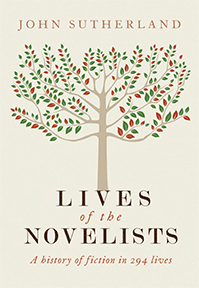By Lewis Fried
Lives of the Novelists is not, of course, the entire history of fiction in English. It is not an academically detailed account of 294 lives. It is not an achingly dull work examining fiction in terms of post-modernist “discourse” with its turgid rhetoric, notable for disguising banalities by means of jargon du jour. It is, however, a clearly written, witty, and sophisticated book presenting us with a commodious, albeit idiosyncratic history of English and American literature. In short, Lives of the Novelists is a delight to read. And read it one should: much like any work that commands attention, offers insight, and reveals a writer who is also intertwining biography and interpretation.
Sutherland makes clear that fiction should not be disentangled from an account of the lives of its authors. Some readers of this book will be captious about what is an old-fashioned enterprise, going back to earlier “lives” of poets and novelists, pace Dr. Johnson and Walter Scott. Others may well dismiss a work that does not measure who is “up” and who is “down” or claim that a book without a trendy, contemporary ideology is not a merit in itself. (Let’s set aside for the purpose of a short review whether ways of knowing implicate invariable terms of discussing.)
Sutherland’s work is extensive, the entries beginning with John Bunyan and closing with Rana Dasgupta. It ingathers writers who made names for themselves in almost every category, subject, and form. Each entry, with an epigraph, is usually about two or three pages, and accompanied by a bibliography listing a standard biography, a “Must Read Text,” and the selected author’s full name.
Yes, Sutherland is aware of constraints. How can one work cover such a large field? And yes, Sutherland lets us know that the writers he has chosen have “meant something” to him or have drawn his attention over his own life of reading. He writes that he has tried to achieve “breadth.” And a final yes: there are authors he has omitted. As a result, Lives of the Novelists reveals a great deal of Sutherland’s own reading history, as well as his understanding of the history of reading.
Who catches Sutherland’s interest? I’m more intrigued by the names that are unfamiliar to most contemporary readers than by the writers who compose an ever-normal canon. We may have forgotten, or never have read authors such as Vicki Baum (whose Menschen im Hotel became known in English as Grand Hotel), or Jim Thompson (whose The Killer Inside Me pretty much explains the protagonist’s struggles); we should be reminded of the racist voices that haunt literature, such as William Pierce, who wrote the neo-Nazi The Turner Diaries, under the pen name of Andrew Macdonald; we might take a look at John Kennedy Toole’s The Neon Bible, which Sutherland points out throws biographical light “on this strangest of novelists”; and we ought to read the works of the final entry, Rana Dasgupta, who disputes Walter Benjamin’s perception that the novel is the “end of story-telling and a symptom of the end of community”—as Sutherland puts it.
Lives of the Novelists ends with a brief meditation on the projected future of fiction. About one hundred years ago, Henry Adams, in The Education of Henry Adams, and in other writings, wondered about the age of ether—a period in the then not-distant future in which abstraction would be piled upon abstraction, offering us a new chaos and confusion. Sutherland wonders how we will confront an “unmanageable surplus” of the works composing our literary culture. Having moved from an age of single-house publishers to agglomerations, from a reasonably definable book industry to a “fusion” of many “produces (here, Sutherland cites “literary agents, publishers retailers—electronic and walk-in, transnational reading publics”), we now will have fiction “which will never see a printed page” but will attract numerous readers. Moreover, the illustrated novel will anchor itself (as it is already doing) in our contemporary literary traditions. Are these not the confusions and confoundings of our own contemporary sensibilities and creations?
All this makes worthwhile asking if literature itself, that great triumph of the imagination relating self to society, and both to the reader, will de-evolve, catering to the problems of illustrated fiction: rinsing out the density of prose and its evocative power while not being able—as of yet—to appeal to the rich and luxurious traditions of art and iconography. Although Sutherland does not ask this, he does have the last—and joyful—declamation: “For the moment we can, and should, revel in the plenty which we, unlike all previous generations, enjoy. Long live the novel, and Walter Benjamin be damned.”
Lewis Fried (ΦBK, Queen’s College, CUNY, 1964) is Professor of English Emeritus at Kent State University and a resident member of the Nu of Ohio chapter of Phi Beta Kappa.




